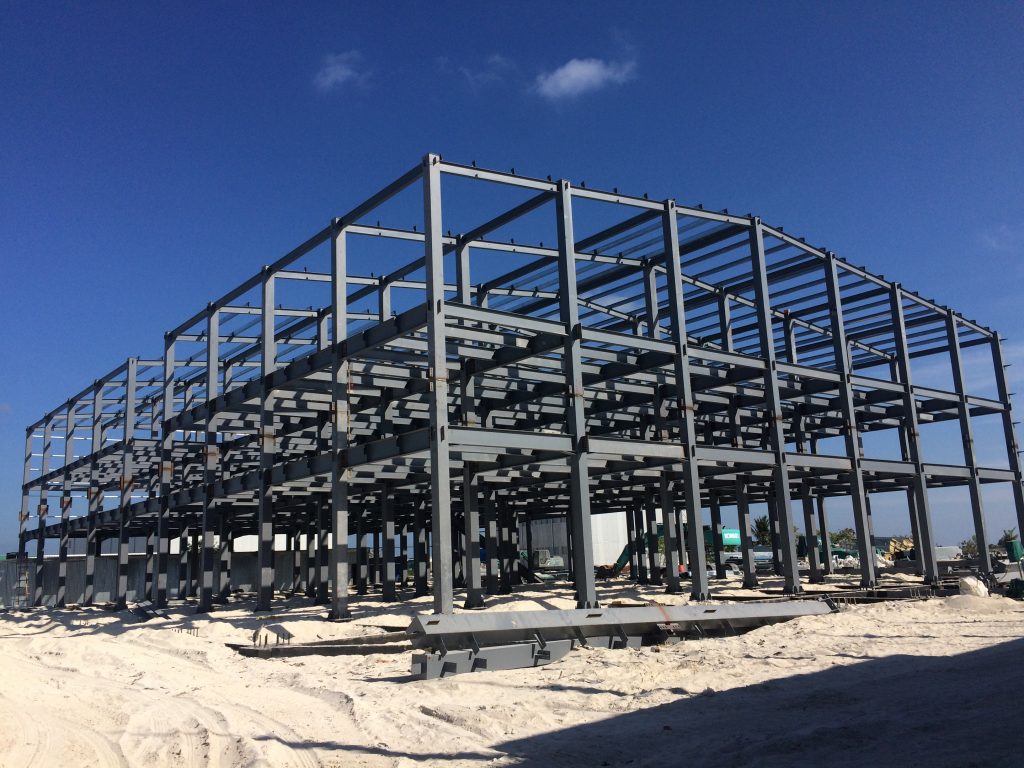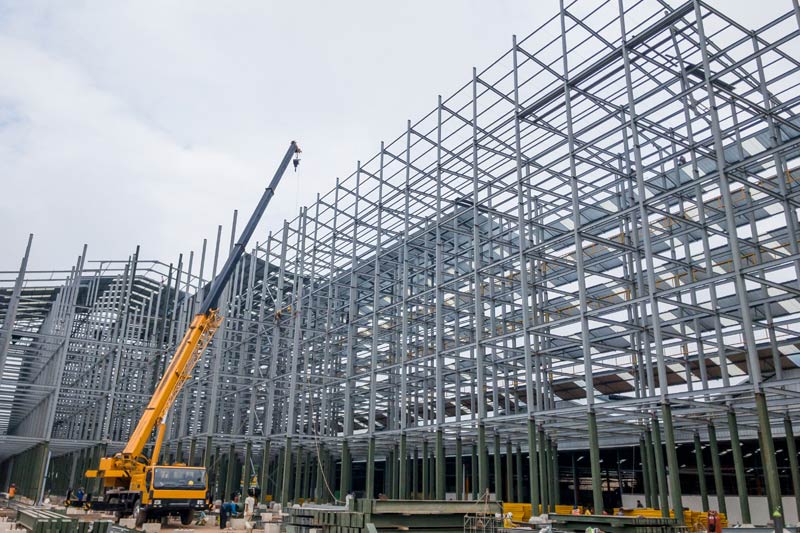Brand Name: Lida
Material: Sandwich Panel, Steel Structure
Use: Steel Structure Building
Certificate: CE (EN1090), SGS ,BV, ISO9001, ISO14001, ISO45001
Delivery time: 15 to 30 days
Payment Terms: T/T, LC
Brand Name: Lida
Material: Sandwich Panel, Steel Structure
Use: Steel Structure Building
Certificate: CE (EN1090), SGS ,BV, ISO9001, ISO14001, ISO45001
Delivery time: 15 to 30 days
Payment Terms: T/T, LC
In recent years, there has been a significant rise in the popularity of steel structure construction. With its numerous advantages and versatility, steel has become the material of choice for constructing a wide range of buildings, from commercial complexes to residential homes. This introduction aims to shed light on the reasons behind this growing trend and explore the advantages that steel structures offer over traditional construction methods.
Steel structure construction refers to the process of building structures using steel as the primary material for framing and support. Unlike traditional construction methods that heavily rely on wood or concrete, steel frame construction offers several distinct advantages. Firstly, steel structures are known for their exceptional strength and durability. Steel is highly resistant to harsh weather conditions such as extreme temperatures, high winds, and seismic activities. This makes it an ideal choice for areas prone to natural disasters.
Additionally, steel buildings are known for their flexibility in design and quick assembly. With pre-engineered components manufactured off-site, construction time can be significantly reduced compared to other materials. Furthermore, due to its high strength-to-weight ratio, steel allows for larger open spaces without the need for excessive supporting columns or walls.
Another advantage of steel structure construction is its sustainability aspect. Steel is a recyclable material that can be reused multiple times without losing its properties. By choosing steel over other materials, builders contribute to reducing waste and minimizing their environmental impact.
In conclusion, the rise of steel structure construction can be attributed to its numerous advantages such as strength, durability, flexibility in design, quick assembly time, and sustainability. As more industries recognize these benefits and embrace this innovative approach to building construction projects both large and small are turning towards utilizing this modern solution.
When it comes to durability and strength in construction, steel structures outperform traditional materials in numerous ways. The benefits of using steel as a construction material are undeniable, making it the go-to choice for architects, engineers, and builders worldwide.
One of the key advantages of steel structures is their exceptional durability. Unlike other materials that deteriorate over time, steel buildings are built to last. Steel is highly resistant to corrosion, rust, and pests, ensuring that the structure remains intact even in harsh environments or extreme weather conditions.
Additionally, steel boasts unparalleled strength compared to traditional construction materials. Its high tensile strength allows for greater load-bearing capacity and structural stability. This means that steel structures can withstand heavy loads and forces without compromising their integrity.
The long-lasting nature of steel structures further contributes to their superiority over traditional materials. With minimal maintenance requirements and a lifespan that exceeds many other construction options, steel buildings offer a cost-effective solution in the long run.
Whether it’s for commercial buildings, industrial facilities, or residential homes, opting for steel as a construction material guarantees a durable and strong structure that stands the test of time. With its proven track record and numerous benefits, it’s clear why steel structures continue to outperform traditional construction materials in terms of durability and strength.

When it comes to construction projects, cost-effectiveness is a crucial factor to consider. This section will shed light on how steel structure construction can save you money in the long run.
One of the main reasons why steel structures are considered cost-effective is due to the affordability and availability of steel as a construction material. Compared to other traditional materials, such as concrete or wood, steel is often more economical to purchase and transport. This makes it an attractive option for projects with tight budgets.
Additionally, steel structures offer significant savings in terms of maintenance costs. Unlike other materials that may require frequent repairs or replacements, steel is known for its durability and longevity. It can withstand harsh weather conditions, resist corrosion, and remain structurally sound for decades without extensive maintenance needs.
The reduced maintenance requirements translate into long-term savings for construction projects. With fewer repairs and replacements needed over time, the overall cost of maintaining a steel structure is significantly lower compared to alternative materials.
Furthermore, steel structures are known for their versatility and ease of modification. This flexibility allows for future expansions or alterations without major disruptions or expenses. The ability to adapt and expand the structure as needed ensures that your investment remains cost-effective in the long run.
In conclusion, opting for steel structure construction offers several advantages when it comes to cost-effectiveness in construction projects. From initial affordability and availability to reduced maintenance costs over time, choosing steel can lead to significant savings while ensuring a durable and adaptable building solution.
When it comes to building design, flexibility and versatility are key factors that architects and designers consider. Steel structures offer a wide range of design possibilities, allowing for flexible building design options and customized architecture.
One of the main advantages of steel structures is their ability to adapt to various architectural styles and requirements. Whether it’s a sleek modern design or a traditional aesthetic, steel can be shaped and manipulated to achieve the desired look. This flexibility allows architects to create unique and innovative designs that cater to specific client preferences.
Moreover, steel structures offer versatility in terms of functionality. They can be used for a variety of purposes such as commercial buildings, residential complexes, industrial facilities, and even bridges. The strength and durability of steel make it an ideal choice for projects that require long spans or complex geometries.
In addition to its design flexibility and versatility, steel also offers numerous benefits in terms of sustainability and cost-effectiveness. Its recyclability makes it an environmentally friendly option, while its durability reduces maintenance costs in the long run.
In conclusion, the flexibility and versatility offered by steel structures provide architects with endless possibilities for creating customized architecture. From unique designs to functional spaces, steel is a reliable choice that allows for creative expression while meeting client needs.

In the era of increasing environmental consciousness, the focus on sustainable building materials and eco-friendly construction practices has become paramount. One such material that stands out for its green aspect is steel.
Steel structures offer a range of benefits when it comes to sustainability and environmental friendliness. Firstly, steel is a highly recyclable material, with a recycling rate that exceeds any other construction material. This means that steel components can be easily reused or repurposed, reducing the demand for new resources and minimizing waste.
Moreover, the production of steel involves significantly less energy compared to other materials like concrete or timber. This energy efficiency translates into lower carbon emissions during the manufacturing process, making steel structures an environmentally responsible choice.
Additionally, steel structures are known for their durability and longevity. With proper maintenance and care, they can last for decades without needing significant repairs or replacements. This longevity reduces the need for frequent rebuilding or renovation projects, further contributing to sustainable practices by conserving resources.
In conclusion, when it comes to sustainable building materials and eco-friendly construction practices, steel structures shine as a prime example. Their recyclability, energy efficiency during production, and long-lasting nature make them an excellent choice for those seeking environmentally responsible solutions in construction projects.
In today’s fast-paced world, time is of the essence in every industry, and construction is no exception. The use of steel structures has revolutionized the building process by expediting project timelines and reducing construction timeframes significantly.
One of the key advantages of steel structures is their ability to facilitate a faster building process. Compared to traditional construction methods, steel structures can be erected much more quickly. This is due to the pre-engineered nature of steel components, which are manufactured off-site and then assembled on-site.
The reduced construction timeframes associated with steel structures can be attributed to several factors. Firstly, the prefabricated nature of steel components allows for efficient production and assembly, minimizing delays caused by weather conditions or other external factors. Additionally, the lightweight yet durable properties of steel make it easier to transport and handle on-site, further speeding up the construction process.
Furthermore, steel structures offer greater flexibility in design and customization compared to other materials. This enables architects and engineers to optimize project plans for efficiency without compromising on aesthetics or functionality. By streamlining the design process and eliminating unnecessary complexities, construction projects utilizing steel structures can proceed at a much faster pace.
The speed at which steel structures expedite project timelines has significant implications for various sectors such as commercial buildings, industrial facilities, and even residential constructions. Clients benefit from reduced disruption caused by lengthy construction periods while also enjoying earlier occupancy or utilization of their buildings.
In conclusion, the use of steel structures in construction offers numerous advantages including a faster building process and reduced construction timeframes. As industries continue to demand quicker turnarounds without compromising quality or safety standards, embracing this innovative approach becomes increasingly vital for staying competitive in today’s fast-paced world.

In conclusion, embracing the future with steel structure construction is a decision that holds immense potential and benefits. As we have explored throughout this section, steel structures offer durability, versatility, and sustainability that surpass traditional construction methods.
By utilizing steel in construction projects, we can create buildings that are not only aesthetically pleasing but also structurally sound and environmentally friendly. The strength and flexibility of steel allow for innovative architectural designs while ensuring the safety of occupants.
Furthermore, the use of steel in construction aligns with the growing trend towards sustainable practices. Steel is a highly recyclable material, reducing waste and minimizing the carbon footprint associated with traditional building materials.
As we move forward into an era where efficiency and sustainability are paramount, embracing steel structure construction is a logical step towards creating a better future. Its numerous advantages make it an ideal choice for various applications such as residential buildings, commercial complexes, industrial facilities, and even infrastructure projects.
In conclusion, by embracing steel structure construction, we not only benefit from its inherent qualities but also contribute to a more sustainable and resilient built environment. Let us embrace this future-oriented approach to construction and unlock the endless possibilities that lie ahead.

Our team will use our experience to provide the professional services .
